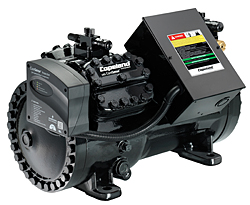
|
| Emerson Climate Technologies CO2 transcritical compressor. |
In stationary, more products are becoming available that work with CO2 refrigerant. For example, on Jan. 27, Emerson Climate Technologies announced it has received Underwriters Laboratories (UL) recognition for its new line of semi-hermetic compressors that utilizes CO2 as its refrigerant.
This new design is currently available in 12-, 15-, and 28-hp sizes, allowing it to be used in a variety of applications, such as grocery stores and supermarkets.
According to a statement from Emerson, “UL recognition is critically important in the refrigeration industry as it identifies compressors that meet global safety standards, ensuring products have been thoroughly tested and achieve a predetermined set of international performance guidelines.”
“For those customers who want compressors that use a natural refrigerant, Emerson’s new line of compressors are one of only a handful of transcritical units that have received UL recognition,” said Mitch Knapke, market manager, food retail, Emerson Climate Technologies. “And because CO2 runs hotter than other refrigerants, it becomes an excellent candidate for use in heat recovery.”
Emerson called transcritical compressors “the next step in the evolution of semi-hermetic designs. Similar to subcritical compressors, transcritical compressors can be used for both low- and medium-temperature applications, but without the limitations of requiring the refrigerant go through a phase change from liquid to gas.”
Mobile Applications
Things are a bit more muddled in the European refrigerant sector, where both CO2 and a new f-gas refrigerant, HFO-1234yf, are being promoted as effective in auto air conditioning. There is an automotive usage phaseout scheduled for HFC-134a in Europe, but not in the United States.
According to the website www.r744.com, in a March 7, 2013, announcement: “After a clear commitment in 2007 to use CO2 as the refrigerant in mobile air conditioning (MAC), reconfirmed in 2008, and followed by a subsequent preference for the chemical refrigerant 1234yf, Daimler, backed by four … carmakers, has taken yet another U-turn, announcing the further development of CO2 technology as a ‘sustainable and safe solution.’ The group has the support of the German automotive association VDA.
“However, out of the manufacturers’ group, only Daimler R&D development chief Thomas Weber is quoted as saying, ‘We are delighted that we were able to agree on this sustainable and safe solution together with Audi, BMW, Porsche, and Volkswagen (VW), with the involvement of the VDA.’”
Then the next day from the same site came this announcement: “Volkswagen is … making the game-changing announcement that they will use CO2 as the refrigerant in MAC.
“According to the VW press release, CO2 “is exceptionally well-suited for a/c systems in cars that are designed for CO2 refrigerants. With a global warming potential (GWP) of 1, it beats the EU’s GWP limit of 150 by 99.3 percent.”
Not That Clear
In a press release issued a few months before, in January 2013, the f-gas refrigerant manufacturer Honeywell, said that R-1234yf was still in play.
Honeywell said it “welcomed implementation of the European Union’s Mobile Air Conditioning (MAC) Directive, aimed at reducing greenhouse gas emissions by requiring use of automotive refrigerants with significantly lower global warming impact.”
The directive came into force on Jan. 1, 2013, and the company said it is fully prepared to supply automakers with HFO-1234yf, a new lower-global-warming-potential refrigerant that has been proven to be a safe and effective replacement for HFC-134a and is already in use by the auto industry.
Compared with HFC-134a, HFO-1234yf offers a 99.7 percent improvement in global warming potential, the company said.
“Honeywell has been preparing to assist automakers meet this milestone directive, investing in research to develop HFO-1234yf, which is the alternative refrigerant that best meets the requirements for safety, effectiveness, and energy efficiency,” said Dr. Ian Shankland, chief technology officer for Honeywell Performance Materials and Technologies. “HFO-1234yf is a near drop-in replacement for HFC-134a, making it easy and cost-effective for automakers to comply with the MAC Directive.”
The European Union’s F-Gas Regulation (842/2006), passed in July 2006 and enforced through the MAC Directive, aims to reduce emissions of specific fluorinated greenhouse gases in the air conditioning systems in passenger cars and light commercial vehicles. The directive requires that refrigerants in all new type vehicles sold in Europe after Jan. 1, 2013, have a GWP below 150 and that all cars sold after 2017 meet the lower GWP requirement. HFC-134a has a GWP of 1,430, while HFO-1234yf has a GWP of 4.
In its statement, Honeywell said that according to a third-party study, if all cars in Western Europe today were converted from HFC-134a to HFO-1234yf, it would result in a reduction of an equivalent 8 million tons of carbon dioxide emissions per year — or removing 4 million cars from the road.
Honeywell said that the European Commission, at a December 2012 meeting of its Technical Committee – Motor Vehicles (TCMV), reconfirmed that the MAC directive would be fully enforced starting on Jan. 1.
Honeywell said HFO-1234yf has been “exhaustively and extensively evaluated by respected global testing agencies, including SAE International, which concluded after a three-year evaluation of the refrigerant involving 15 global automakers; 17 top automotive suppliers; and 18 international, independent research institutes that the refrigerant is safe and effective in automotive applications.”
SAE International, formerly known as the Society of Automotive Engineers, is an independent, global association of more than 133,000 engineers and related technical experts in the aerospace, automotive, and commercial-vehicle industries.
Publication date: 4/22/2013



Report Abusive Comment